Archive for the ‘Threats from Development’ Category
Tuesday, June 14th, 2011
 This is a Tiger Quoll (Dasyurus maculatus) This is a Tiger Quoll (Dasyurus maculatus)
Photo courtesy of Sean McClean.
.
It is Australia’s largest carnivorous marsupial on the mainland and it has become endangered because of humans destroying its habitat, shooting it and poisoning it.
It is not a cat. Much information may be obtained online simply by typing ‘tiger quoll’ on Google.
.
.
.
The following extract is from the website ‘Convict Creations‘ (15-Feb-2010):
‘Tiger Quoll…the next to die’
“Without disrespecting the Koala or Kangaroo, the Tiger Quoll is one of Australia’s most interesting animals. It sort of resembles a cat except it has a pouch, bright eyes, a moist pink nose and a powerful bite. It can grow to up to 75 cm in length and weigh up to 7kg. If trained, it will even use a kitty litter tray.
The Tiger Quoll is the type of animal that tourists would love to see on their Australian safari.
Unfortunately, they are quite rare so few have ever caught a glimpse of them.
European colonisation of Australia could have been great for the Tiger Quoll. With Europeans introducing rabbits, rats and mice, the Quoll saw a drastic increase in its food source. Had the colonists warmed to them, then a mutually beneficial relationship could have formed. Farmers could have encouraged Quolls to take up residency in order to keep rodent numbers down with little fear that their livestock would be in danger. As an added bonus, by eating carrion, the Quolls would have reduced the threat of blowfly strike.
Alternatively, they could have just made pets out of the Quoll. Apparently the Quoll has all the positive characteristics of a cat or dog. According to Professor Mike Archer, Former Director of the Australian Museum, who once kept a Quoll as a pet:
“I just can’t praise these animals highly enough as companions for human beings. They have all the good features in dogs and cats, and in my experience not a single downside”.
If colonial owners had taken care of their Quolls, then both Quoll and owner would have been happy. If not, the Quoll would have just escaped and done Australia a service by cleaning up decaying meat, rabbits and other introduced vermin.
Unfortunately, colonists never formed mutually beneficial relationships with the Quoll. Instead, they introduced the cat to serve the role of pest controller. For more than a century, farmers deliberately released cats onto their properties in order to control rabbit and mice populations. Once the cats went feral, they started to compete with the Quoll for food. Although the Quoll was better adapted to Australia’s cycle of droughts, the cat’s symbiotic relationship with humans proved to be an even better environmental adaptation. If feral cats were ever wiped out in a drought, or declined for whatever reason, they still had the family home as an oasis in the desert. From the family home, they were well placed to repopulate the bush once good conditions returned.
Even worse than competition from the cat were the environmentalists’ attempts to “help” them. The use of 1080 poison has been one of the main helping strategies. When it is used to kill rabbits, it indirectly deprives Quolls of food. So much so, by killing rabbits, human deprive Quolls of even more food than is lost due to competition by cats. To compound matters, when 1080 poison is used to kill the cats and foxes competiting with Quolls, it also ends up being eaten by Quolls. In fact, Quolls are more likely to eat the poisons because they have a keen nose for carrion while the feral predators prefer fresh kills.
A very odd example of the misguided environmental policy was recently seen in in Tasmania. 1080 was first used to reduce rabbit numbers. A rumour then developed that foxes had finally established a breeding community in the island state. Even though it was just a rumour, to be on the safe side, environmentalists decided a large scale baiting regime needed to be implemented to eradicate foxes as well. On the State Government’s own data, more than 140,000 poison baits were laid. So far, there has been no evidence that foxes were actually present. There was; however, plenty of evidence of Quoll dying!
The odd wilderness protection policy caught the attention of David Obendorf, a vet with a research focus in marsupial diseases. According to Obendorf:
“Three Tasmanians have each offered $1,000 fox rewards (Tasmanian Times: “$1,000 fox reward”). All remain unclaimed despite farmers, landowners and professional shooters all knowing about them. And yet the government “guessimate” claims there are up to 400 foxes living in Tasmania … somewhere. In my opinion Tasmania’s use of 1080 poison over the last five decades – to kill browsing and grazing native herbivores – has had a significant effect on the over-population followed by the facial tumour disease-crash in devil numbers and in the widespread establishment of feral cats across the island….Ironically the state government has now ceased the use of 1080-laced carrot/apple baits on public lands to kill grazing wildlife but now uses tens of thousands of meat baits in public forests where they claim they are targeting those cryptic foxes.” (1)
The use of 1080 poison could be legitimately referred to as Australia’s dumbest environmental policy since the construction of a 1,833 km fence to “keep” rabbits out of WA. It seems that Western Australians weren’t smart enough to realise that rabbits can dig under fences. All that was required was for a single pregnant female to dig a hole and then 1,833 km of fence line would be obsolete. Perhaps WA politicians did in fact realise the folly of it all, but decided it was more to important to show they were “doing something”.
As an added bonus, “doing something” kept people in regional Australia employed. Perhaps 1080 poison is used for similar reasons. Unfortunately, “doing something” to help Quolls is really not helping them at all. It forces them into wilderness reserves where scientists can erect huge fences to keep out ferals and then make a lucrative income maintaining them. (2)
Even though the Tiger Quoll is mainland Australia’s largest native predator, Australia doesn’t have any professional sporting team named after them. In fact, they don’t really exist in public consciousness in any significant shape or form. Perhaps this is because Quolls spend their time out in the bush where they are only ever seen by rangers.
Alternatively, perhaps the name Quoll just isn’t scary enough.
Zoos – The only real industry is as a research subjects by scientists, or to provide an endangered animal story that can be used by wilderness groups to write emotive appeals asking for funding to save them.
Pest controllers – Potentially, Quolls could make great pest controllers. They could compete with cats and foxes for food, and eliminate rabbits and rats in the process. Landowners could breed them and sell them as a substitute to 1080 poison.
Pets – Sometimes scientists have made great pets out of Quolls. At present, the general public is not allowed to do likewise. The general argument is that Quolls require special care that only a scientist can give. Consequently, Australians have to reserve their abusive ownership methods for dogs and cats that simply go bush if they are unhappy with their owners.”
.
.
The Snowy River is a surviving stronghold of the Tiger Quoll
.
“In East Gippsland, the areas on the Errinundra Plateau, Snowy River and Tingaringy are strongholds of the Spot-tailed Quoll”. (GECO)
“The Upper Snowy River and its tributaries was the Victorian stronghold of the Tiger Quoll before (the 2003) devastating Alpine bush fires. The Tiger Quoll is believed to have lost up to 75% of an estimated population of 1,000 in the area.
Following the devastating effects of recent bush fires The Tiger, or Spotted-tailed Quoll (Dasyurus maculatus) has been reclassified as nationally endangered. it is feared that the fires will have a lasting effect on the Quolls that remain.”
.
.
.
References:
[1] ABC, ^http://www.abc.net.au/rn/science/earth/stories/s145805.htm
[2] David Obendorf – ^http://www.animal-lib.org.au/news/1080–the-real-killer.htm”
[3] ^http://www.fame.org.au/current_projects.html
.
~ article by Tigerquoll, first published on CanDoBetter.net 15-Feb-2011
Thursday, June 2nd, 2011
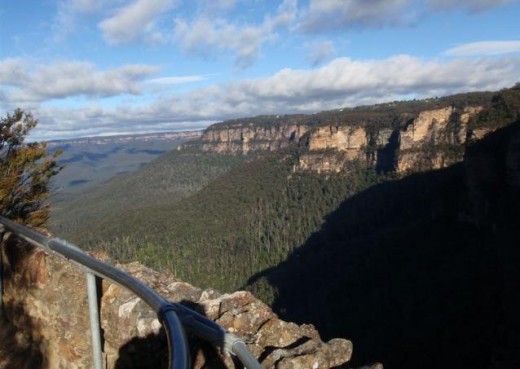 Jamison Valley from Sublime Point, Leura
(Blue Mountains, New South Wales, Australia) Jamison Valley from Sublime Point, Leura
(Blue Mountains, New South Wales, Australia)
.
For those who have purchased an escarpment-edge bush block in Blue Mountains villages of Leura, Wentworth Falls or Katoomba, who have ‘arranged‘ for native escarpment habitat to be killed in order to gain property views to the magnificent Jamison Valley, such actions are selfish and contribute to the ecological vandalism and disappearance of important and scarce escarpment habitat.
For others enjoying the Jamison Valley naturally on foot, to look back up at the Leura escarpment has become an ugly one dominated by increasing housing development.
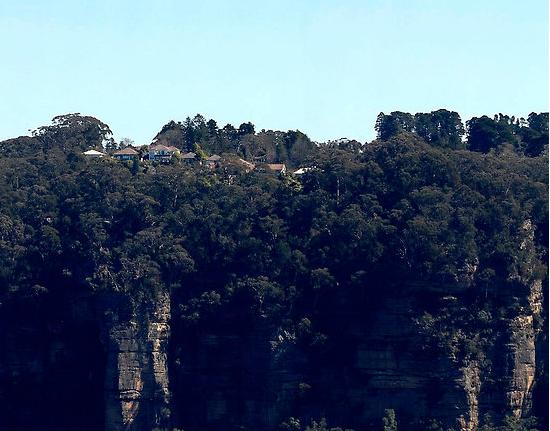
Views are bidirectional, but try explaining that to a property developer or to those real estate agents who only appreciate the sales commission.
On the spectacular escarpment fringe of the much valued village of Leura in the much valued Blue Mountains, not only have the fire-lighters taken a fancy at setting fire to nearby prized escarpment bushland, but the property developers have been in with the bulldozers.
The Blue Mountains (city) Council has for decades signed off on developer applications for clifftop development and consequential deforestation. More recently, Blue Mountains (city) Council continues to happily signed off on approval of applications from subsequent clifftop property owners to ‘hazard reduce’ the surrounding escarpment bushland ~ either to improve the views or to save money having to bushfire protect their properties.
Either way, valuable limited habitat along the Blue Mountains escarpment overlooking the Jamison Valley continues to disappear for new selfish housing views.
All along the Jamison Valley escarpment, the following photos tell a tragic story of the selfish developer destruction of the Jamison Valley Escarpment …
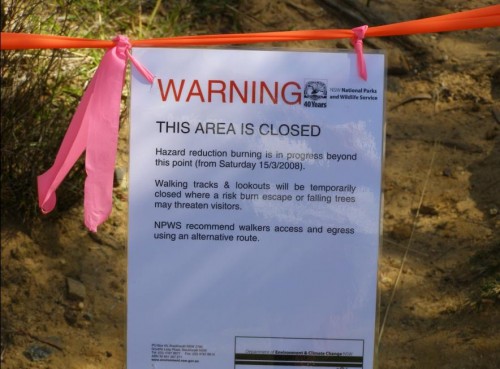 Wildlife Service ‘hazard reduction’ burn notice for Sublime Point escarpment at the end of Willoughby Road, Leura back on 15th March 2008.
(click photo to enlarge) Wildlife Service ‘hazard reduction’ burn notice for Sublime Point escarpment at the end of Willoughby Road, Leura back on 15th March 2008.
(click photo to enlarge)
.
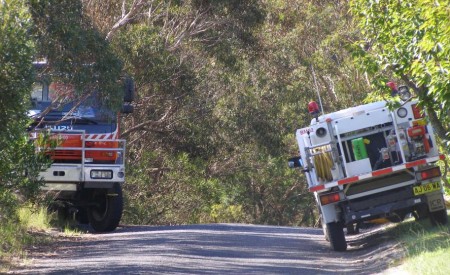 Warrimoo Rural Fire Service set up to conduct hazard reduction at Sublime Point, Leura (Carleton Road, Leura, 15th March 2008). Warrimoo Rural Fire Service set up to conduct hazard reduction at Sublime Point, Leura (Carleton Road, Leura, 15th March 2008).
.
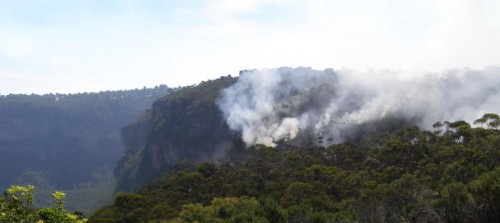
Rural Fire Service setting fire to escarpment vegetation at Sublime Point on the Jamison Escarpment, Leura. (Photo from Willoughby Road,Leura, 15th March 2008).
.
A year later again at Sublime Point…
.
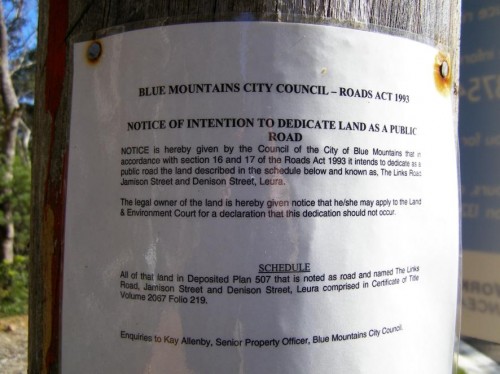 DECC Wildlife Service ‘hazard reduction’ burn notice for Sublime Point escarpment again on 24th March 2009, almost exactly a year to the date. DECC Wildlife Service ‘hazard reduction’ burn notice for Sublime Point escarpment again on 24th March 2009, almost exactly a year to the date.
.
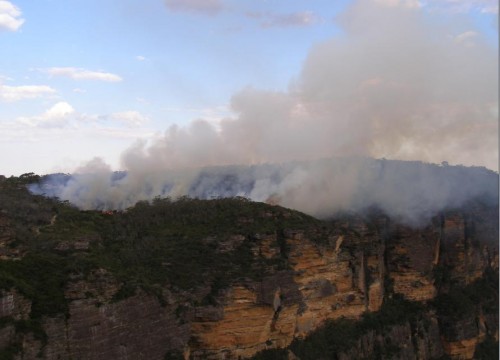 Blue Mountains Wildlife Service ‘hazard reduction’ burn of the Jamison Escarpment at Sublime Point 24th March 2009 Blue Mountains Wildlife Service ‘hazard reduction’ burn of the Jamison Escarpment at Sublime Point 24th March 2009
.
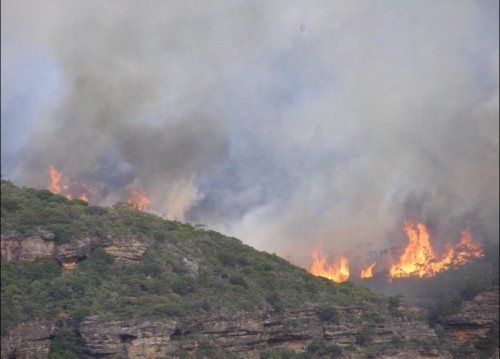 Blue Mountains Wildlife Service ‘hazard reduction’ burn of the Jamison Escarpment at Sublime Point 24th March 2009. Blue Mountains Wildlife Service ‘hazard reduction’ burn of the Jamison Escarpment at Sublime Point 24th March 2009.
.
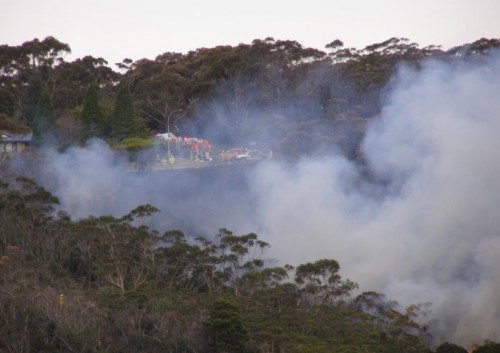 Fire-lighters watching on as their blaze gets out of control at Sublime Point 24th March 2009.
(Click photo for enlargement) Fire-lighters watching on as their blaze gets out of control at Sublime Point 24th March 2009.
(Click photo for enlargement)
.
.
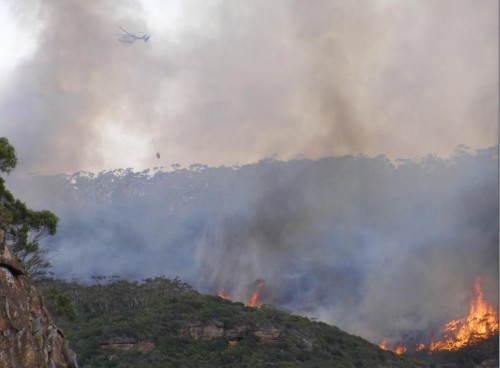 Same ‘hazard reduction’ burn out of control, requiring expensive and embarrassing helicopter water-bombing to stop the fire spread down into the protected Jamison Valley Same ‘hazard reduction’ burn out of control, requiring expensive and embarrassing helicopter water-bombing to stop the fire spread down into the protected Jamison Valley
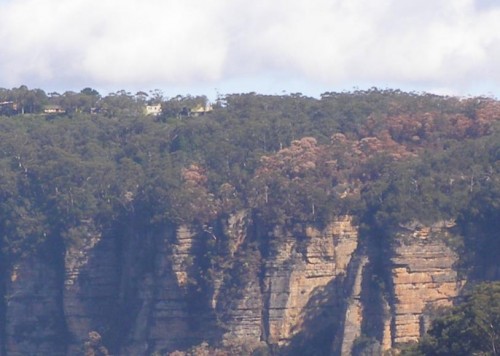 East side of Sublime Point (5th April 2009) showing burnt vegetation, where the HR burning had escaped and nearly entered down into the Jamison Valley.
(The media spin by bushfire management was that this section was arson, but not surprisingly the culprit was never found). East side of Sublime Point (5th April 2009) showing burnt vegetation, where the HR burning had escaped and nearly entered down into the Jamison Valley.
(The media spin by bushfire management was that this section was arson, but not surprisingly the culprit was never found).
.
nec.
Meanwhile, property developers at Sublime Point, a block away…
.

Leura’s recently approved and created ‘ The Links Road‘ (31st May 2008) following Council approved destruction of escarpment vegetation and subsequent subdivision ready for escarpment housing..with views.
.
Meanwhile, further along Cliff Drive at Katoomba…
.
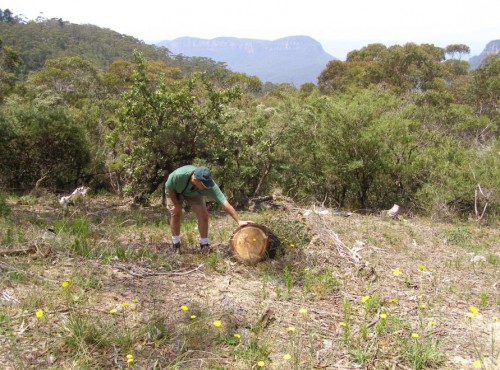 Editor inspecting native escarpment site on Cliff Drive, Katoomba back on 12th January 2008 that had been recently slashed by the Wildlife Service.
It just so happened that a house opposite on Cliff Drive was up for sale and would benefit from the fresh views of the Jamison Valley. Editor inspecting native escarpment site on Cliff Drive, Katoomba back on 12th January 2008 that had been recently slashed by the Wildlife Service.
It just so happened that a house opposite on Cliff Drive was up for sale and would benefit from the fresh views of the Jamison Valley.
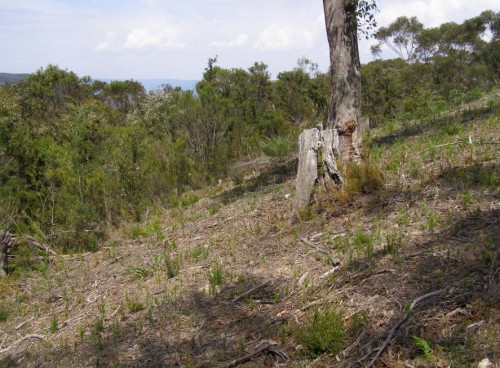 Same site, same date. Same site, same date.
.
 Seven months later, a few hundred metres west along Cliff Drive Katoomba,
some developer gets escarpment views towards Nellies Glen approved,
or is it more a case of ‘overlooked‘ by Blue Mountains (city)Council? Seven months later, a few hundred metres west along Cliff Drive Katoomba,
some developer gets escarpment views towards Nellies Glen approved,
or is it more a case of ‘overlooked‘ by Blue Mountains (city)Council?
.
.
.
-end of article –
Tags: Blue Mountains City Council, Blue Mountains western escarpment, Blue Mountains World Heritage Area, bushland housing, hazard reduction, housing encroachment, Jamison Valley, Katoomba, Leura, Links Road, NPWS, prescribed burning, Sublime Point, Wentworth Falls, Wildlife Service
Posted in Blue Mountains (AU), Threats from Bushfire, Threats from Development | No Comments »
Add this post to Del.icio.us - Digg
Saturday, May 28th, 2011
Valuable fringe bushland of the Central Blue Mountains (BM) is steadily disappearing as a consequence of Blue Mountains (city) Council-approved housing development integrated with the associated hazard reduction burning that it invites.
Blue Mountains Council has become culturally conditioned to automatically squirm and acquiesce when any threat of a State Environmental Court appeal process that may be instigated to dare challenge Blue Mountains Council, despite a fair and rigorous environmental assessment and ruling. Local political pressure is such that now Blue Mountains Council staff are encouraged to give up and bend over, as if so urbane as to be beholden to developer intimidation. Yet for years such has become Blue Mountains Council’s urbane squeamish mindset, as if the staff and management came from overdeveloped Western Sydney (which most of them they have).
There are morally corrupt politics controlling land use development in the Blue Mountains ~ many are receiving a cut of perceived cheap, yet increasingly scarce, bushland habitat.
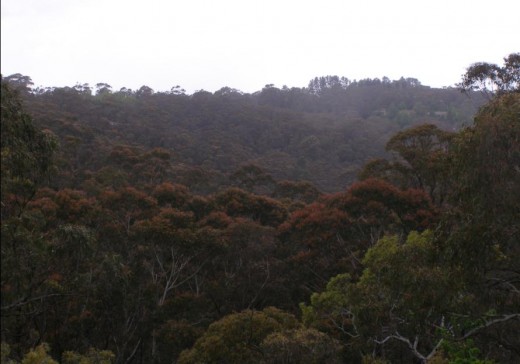 Thick natural bushland habitat just west of Katoomba
Central Blue Mountains Region.
New South Wales, eastern Australia. Thick natural bushland habitat just west of Katoomba
Central Blue Mountains Region.
New South Wales, eastern Australia.
.
.
Case in point:
.
Not so long ago, Blue Mountains Council approved this cypress pine cottage be built in/abutting thick timbered bushland on a west facing slope downwind of the prevaling westerly winds.
Bushfire risk mapping rated the site as ‘extreme’ bushfire risk, yet the cypress pine cottage got built. The builder/developer has long since profited and so moved on, leaving behind a bushfire vulnerable cottage on a site that should never have been built on in the first place.
But try telling a pro-development council that a property owner can’t develop his/her land!
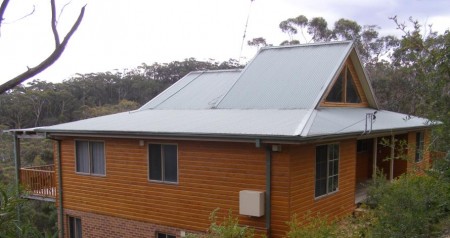 The cypress pine cottage, 2008
. The cypress pine cottage, 2008
.
The site was purchased in/abutting dense wooded bushland, which was slashed and bulldozed. Down from the house, around a dozen mature native trees were chainsawed to provide for escarpment views to the west.
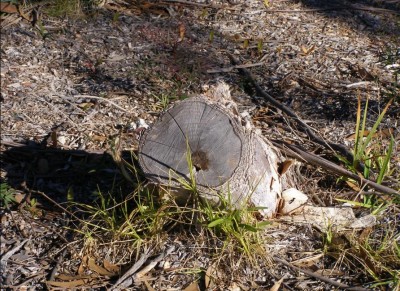 One of the chainsawed native trees
. One of the chainsawed native trees
.
The property has since been sold. Yet, the issue of a cypress clad cottage being approved in extreme fire risk bushland was raised with Blue Mountains Council’s senior development officer, Lee Morgan, on 25-Feb-2009 (Council ref. Customer Service Request #106889). But there was no response.
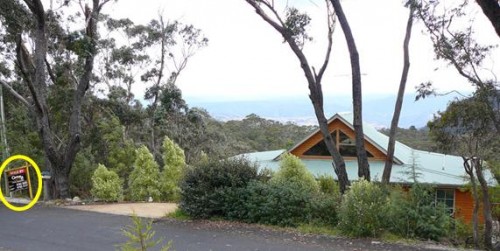 The cottage was sold in 2008…with views
…less the dozen chainsawed Eucalypts to make way for the views. The cottage was sold in 2008…with views
…less the dozen chainsawed Eucalypts to make way for the views.
.
It is typical of Blue Mountains Council’s planning approvals that they encourage development encroachment on the fringe bushland which separates the Blue Mountains National Park from the townships of the Central Blue Mountains.
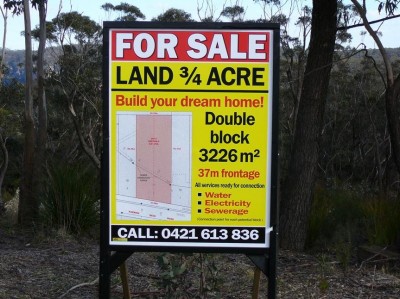
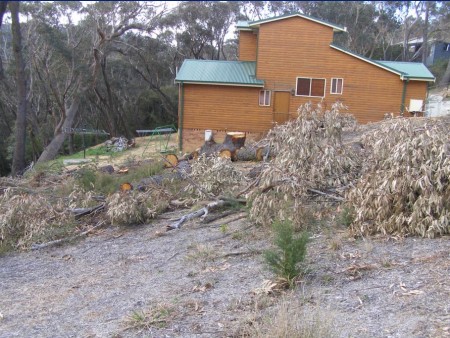 A nearby cottage of remarkably similar cypress pine cladding
has surrounding trees chainsawed and the vegetation slashed to bare earth. A nearby cottage of remarkably similar cypress pine cladding
has surrounding trees chainsawed and the vegetation slashed to bare earth.
.
.
Then comes the ‘hazard’ reduction
.
Housing development encroachment is being wedged deeper into fringe bushland, closer to the Blue Mountains National Park, many seeking the profit that escarpment views bring. The sites are indefensible against bushfire. Many are zoned extreme bushfire risk, yet these bush houses received Council building approval.
The Rural Fire Service (RFS) calls for hazard reduction because, with just its truck resources, it would not have access to defend these houses in the event of a serious bushfire. Co-incidentally, the property owners (developers) now cry for RFS hazard reduction to protect their ‘assets’ from the risk of bushfire. Co-incidentally, many property owners (developers) in the vicinity who have these new bush houses do the same.
Of course, to the fire-lighting cult, this is music to their ears and so the Rural Fire Service in cohorts with Blue Mountains Council rustled up a hazard reduction certificate. In September 2008, Blue Mountains Council’s Bushfire Technical Officer, Peter Belshaw, issued a Hazard Reduction Certificate for over 11 hectares of bushland and escarpment heath across Bonnie Doon Reserve to be burnt under a ‘hazard’ reduction programme. Click on image below for details.
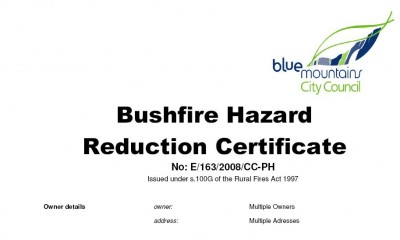 Click image to open PDF document Click image to open PDF document
.
Earlier that year in mid February (2008), some seven months prior, slashing of heathland and a watercourse had been carried out by a Rural Fire Service contractor in preparation for the hazard reduction burning ~ the fire-lighters just couldn’t wait.
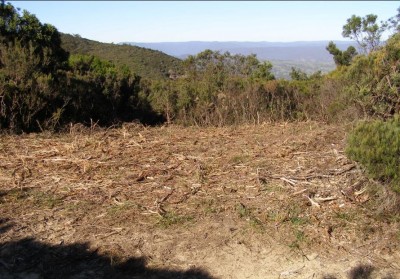 Blue Mountains escarpment is slashed by the RFS, a kilometre west of the cottage site. Blue Mountains escarpment is slashed by the RFS, a kilometre west of the cottage site.
.
.
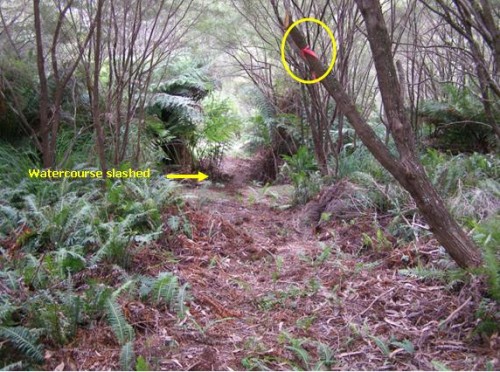 The RFS contractor slashed a trail for over 700m through heathland and through a riparian zone,
even before the Hazard Reduction Certificate was issued.
.
The RFS contractor slashed a trail for over 700m through heathland and through a riparian zone,
even before the Hazard Reduction Certificate was issued.
.
Then comes the intense HR burning:
.
Three years hence, mid afternoon on Friday 11th February 2011, smoke can be smelt and seen rising to the west on the horizon near Bonnie Doon Reserve. A call to emergency ‘000’ confirms that it is not a bushfire, but that official hazard reduction operations are underway. It is still well within the bushfire risk season.
.
Bonnie Doon Reserve is a natural wild area of about 22 hectares that includes a mix of bushland, heathland and upland swamp situated on the Blue Mountains escarpment at the western fringe of the township of Katoomba. It lies above Bonnie Doon Falls. The area is zoned ‘community land’ and ‘environmental protection’ and comes under the control and custodianship of the Blue Mountains Council. Bonnie Doon Reserve has a history of volunteer bushcare to conserve the still wild Blue Mountains escarpment habitat. The reserve is immediately upstream of the endangered Dwarf Mountain Pine (Microstrobos fitzgeraldii) and Leionema lachnaeoides (yellow flowering shrub) found almost nowhere else on the planet. The habitat conservation of both species, particularly the exclusion of fire are considered critical to their survival as a species.
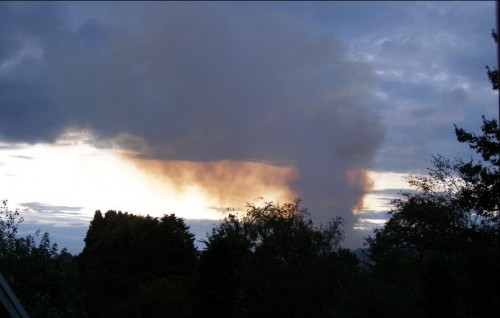 The ‘hazard’ reduction (HR) burning commences The ‘hazard’ reduction (HR) burning commences
.
From a distance of about two kilometres, I can see the smoke billowing strongly and its lasts for over two hours. The direction of the smoke places it around Bonnie Doon Reserve. The strength and density of the smoke indicates that it is more than light burning of ground cover. It is an intense but localised fire.
.
The aftermath of the burning:
.
We have our suspicions, but with other commitments we can’t get around there for some time to investigate the location affected to determine the scale and severity of the burning. In fact it isn’t until nearly three months later on Sunday 1st May 2011, that we inspect the burnt site. The fire was localised.
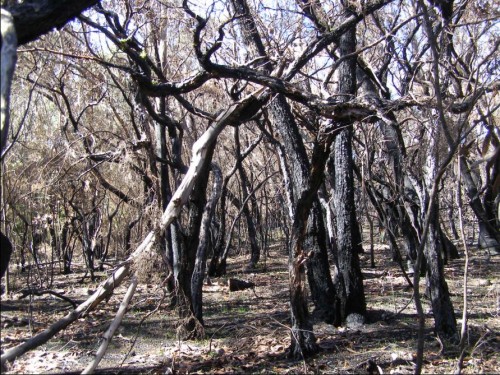 The aftermath
Three months on, evidence of more than just ground-cover has been burnt.
Deliberate intense burning has been allowed to penetrate deep into mature Eucalypts The aftermath
Three months on, evidence of more than just ground-cover has been burnt.
Deliberate intense burning has been allowed to penetrate deep into mature Eucalypts
.
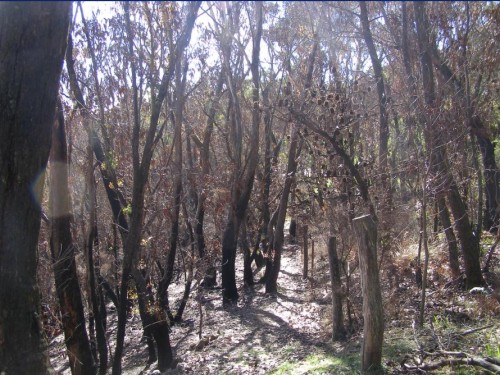
.
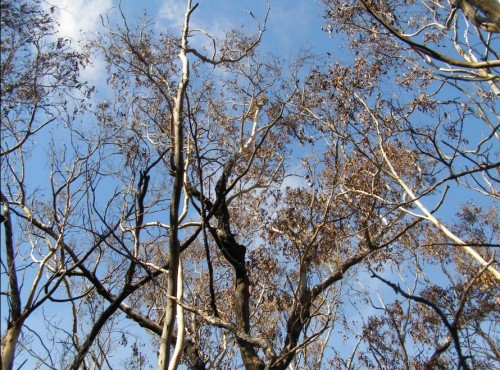 The fire was so intense that the flames reached into the tree canopy.
It must have been a blaze and half for RFS fire-lighters. The fire was so intense that the flames reached into the tree canopy.
It must have been a blaze and half for RFS fire-lighters.
.
.
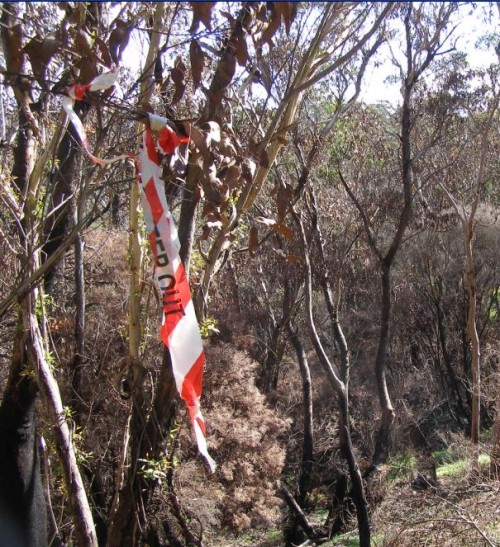 RFS telltale
. RFS telltale
.
The fire was indeed localised. It is very clear, still three months on, that this ‘hazard’ reduction burn had specifically targeted the native bushland surrounding the cypress cottage – an area of perhaps two hectares.
Consequence:
So not only has the developer of the cottage site completely destroyed the bushland on the site, but he has succeeded in having an additional two hectares burnt in the process all associated with the one cottage. Council’s initial approval of the cottage construction has directly led to the destruction of two hectares of what began as intact native bushland. The developer has profited from the bush, but in the process the ecological cost has been ignored ~ it is a perpetuation of a 19th and 20th Century single bottom line exploitation of the natural environment. It is happening across the Blue Mountains and being encouraged by Blue Mountains Council rules, practices and attitudes.
.
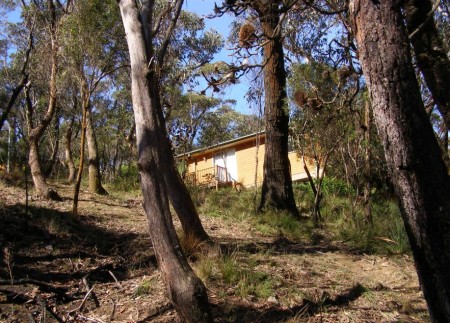 The cottage relative to the HR burn (aftermath) The cottage relative to the HR burn (aftermath)
.
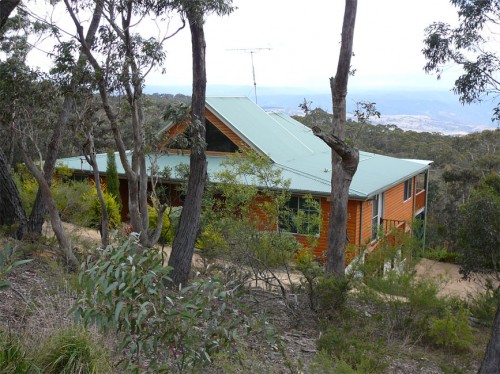
The cottage now with great views, plus an extra 2 hectares of cleared bush done cheap
Blue Mountains (city) Council making bushland-fringe development cheap
.
The ‘hazard’ reduction certificate process has become an insidious part of the development process across the Blue Mountains. The catalyst that is Council’s lax bushland protection zoning, is facilitating fringe deforestation. The combination of Council’s housing approvals on bush blocks with its ‘hazard’ reduction approvals have become a self-perpetuating twin mechanism for incremental encroachment into Blue Mountains fringe bushland, and it shows no sign of stopping.
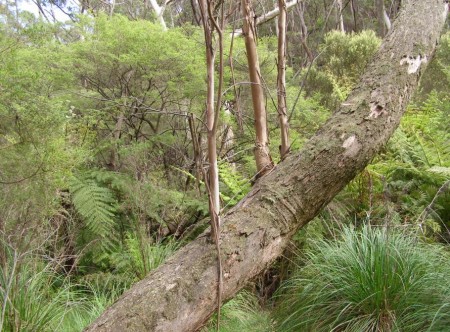 Bushland habitat at Bonnie Doon at risk of further burning Bushland habitat at Bonnie Doon at risk of further burning
.
Hazard reduction has become a cosy win-win-win-win outcome for all collaborators: (1) the builder/developer who profits, (2) the real-estate agent who get the sales commission (first when the bush block is sold, then again when the house is sold with views), (3) Council which earns developer charges in the short term and an expanded rate revenue base over the long-term, and (4) the RFS fire lighters who have become more adept and occupied lighting bushfires than putting them out.
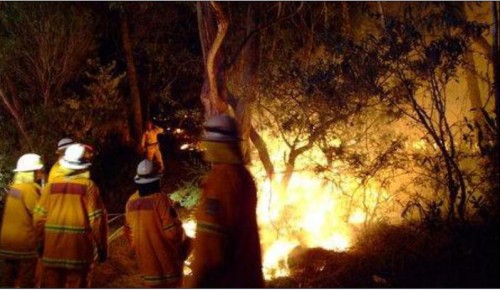 Fire-lighters look on during the Hazard Reduction Burn, Bonnie Doon Reserve Fire-lighters look on during the Hazard Reduction Burn, Bonnie Doon Reserve
.
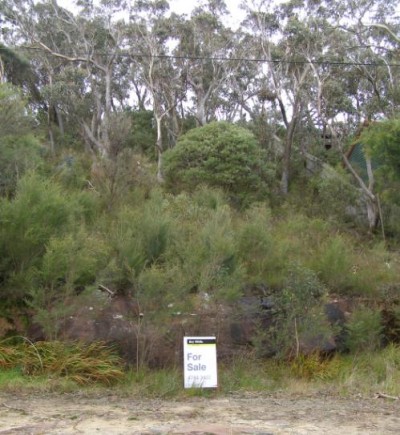 More bushland for sale
~ a ‘lose-lose’ outcome for native habitat and the remnant disappearing wildlife is supports.
More bushland for sale
~ a ‘lose-lose’ outcome for native habitat and the remnant disappearing wildlife is supports.
.
An harbinger of more burning for Bonnie Doon:
.
Of the eleven odd hectares of the 22 ha Bonnie Doon Reserve targeted by the RFS for slashing and burning on the hazard reduction certificate, nine hectares of bushland and escarpment heathland still stands to be burnt, which could happen anytime.
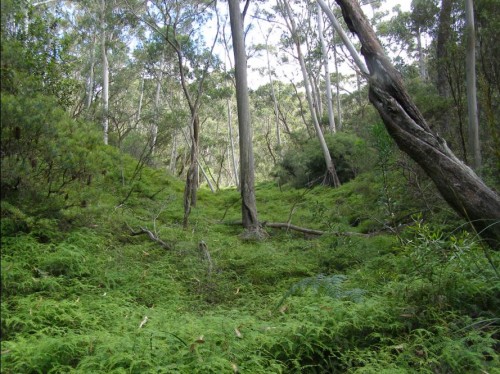 Bonnie Doon Reserve
on the western fringe of Katoomba township Bonnie Doon Reserve
on the western fringe of Katoomba township
(click photo to enlarge)
(Photo by us, so free in public domain)
.
– end of article –
.
 Blue Mountains escarpment is slashed a kilometre west of the house site Blue Mountains escarpment is slashed a kilometre west of the house site
, in preparation for over 11 hectares of buring Bonnie Doon Reserve
Tags: Blue Mountains City Council, Blue Mountains National Park, Blue Mountains World Heritage Area, Bonnie Doon Reserve, bush block for sale, bush fringe development, bush profits, bushland housing, Dwarf Mountain Pine, extreme bushfire risk, hazard reduction, hazard reduction certificate, housing encroachment, Leionema lachnaeoides, Microstrobos fitzgeraldii, property development, real estate land sales, Rural Fire Service, slashing
Posted in Blue Mountains (AU), Threats from Bushfire, Threats from Deforestation, Threats from Development | No Comments »
Add this post to Del.icio.us - Digg
Wednesday, December 22nd, 2010
 Tawny Frogmouths, Glebe (Sydney inner suburb)
Photo: ©2010 Edwina Pickles, Sydney Morning Herald, 20101222.
. Tawny Frogmouths, Glebe (Sydney inner suburb)
Photo: ©2010 Edwina Pickles, Sydney Morning Herald, 20101222.
.
It is pleasing to learn that the City of Sydney council is funding $100,000 into its first serious biodiversity survey of inner Sydney, which is expected to take three months.
The aim is to support biodiversity information for an “urban ecology strategic action plan to conserve indigenous plant and animal species and identify ways to improve their habitats.”
The council has engaged the Australian Museum (located in the Sydney CDB) and specifically ecologists Henry Cook and Glenn Muir to identify all the native animals and plants living in inner Sydney. According to an article in the Sydney Morning Herald today, Sydney has long lost most of its native fauna to 220 years of urban development and habitat destruction.
Amazingly, Native Green and Golden Bell Frogs and Grey-Headed flying foxes still exist in one or two isolated locations but are endangered. Brush-tailed possums, Ring-tailed possums and native water rats are amongst the more adaptable to human incursion, albeit often persecuted.
The ecologists expect to find about 60 indigenous bird species and several reptile and frog species and the survey results are due in mid-2011.
[Source: ‘ Old-time residents cast eyes over a changing city‘, by journalist Kelsey Munro, 20101222, Sydney Morning Herald]
Sunday, October 10th, 2010
by Editor 20101010.
Rogue leaf
Believe it or not
I hung on all winter
outfacing wind and snow
.
Now that spring
comes and the birds sing
I am letting go.
-by Northern Irish poet Derek Mahon
.
Across Prehistoric Britain’s wild dense temperate forests, its moors and boglands – wildlife once teamed.
Agrarian Man, followed by the excesses of Industrial Man, wiped out much of this wildlife and decimated its natural habitat – reducing the landscape to paddocks within a network of pastoral hedgerows and leaving a few tokenistic islands of natural reserves to the ruling classes .
But now it seems that even the hedgerows across the British Isles are at risk from Corporate Man’s insatiable quench for land and profit.
Government leaders could rule to defend the remnants of the British Isles’ natural heritage, yet choose not to.
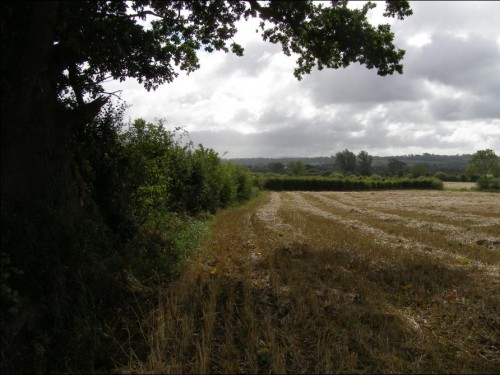 Hedgerows and a hedgerow tree (oak). County Amagh, Northern Ireland.
[Photo and those below taken by the editor 20100916, free on Public Domain – click to enlarge.] Hedgerows and a hedgerow tree (oak). County Amagh, Northern Ireland.
[Photo and those below taken by the editor 20100916, free on Public Domain – click to enlarge.]
.
What is a Hedgerow?
“A hedgerow is a line of closely spaced shrubs and tree species, planted and trained in such a way as to form a barrier or to mark the boundary of a field and used to separate a road from adjoining fields or one field from another.
A hedgerow may consist of a single species or several, typically mixed at random. In most newly planted British hedgerows, at least 60 percent of the shrubs are hawthorn, blackthorn, and (in the southwest) hazel, alone or in combination. The first two are particularly effective barriers to livestock. Other shrubs and trees used include holly, beech, oak, ash, and willow; the last three can become very tall.
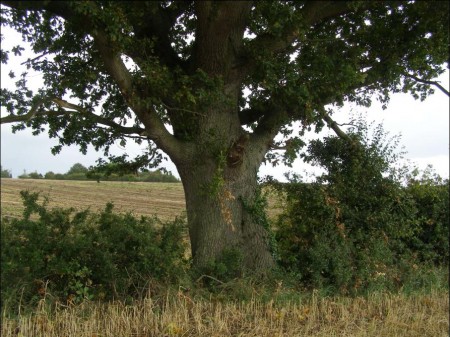 Across the British Isles many hedgerows include fully grown trees (‘hedgerow trees’), typically those mentioned above. There are thought to be around 1.8 million hedgerow trees in Britain (counting only those whose canopies do not touch others) with perhaps 98% of these being in England and Wales. Hedgerow trees are both an important part of the English landscape and are valuable habitats for wildlife. Many hedgerow trees are veteran trees and therefore of great wildlife interest. Across the British Isles many hedgerows include fully grown trees (‘hedgerow trees’), typically those mentioned above. There are thought to be around 1.8 million hedgerow trees in Britain (counting only those whose canopies do not touch others) with perhaps 98% of these being in England and Wales. Hedgerow trees are both an important part of the English landscape and are valuable habitats for wildlife. Many hedgerow trees are veteran trees and therefore of great wildlife interest.
The most common species are oak and ash, though in the past elm would also have been common. Around 20 million elm trees, most of them hedgerow trees, were felled or died through Dutch elm disease in the late 1960s. Many other species are used, notably including beech and various nut and fruit trees. The age structure of British hedgerow trees is old because the number of new trees is not sufficient to replace the number of trees that are lost through age or disease.”
[Source: http://en.wikipedia.org/wiki/Hedge_(barrier)]
“Hedgerows serve as important wildlife corridors, especially in the United Kingdom where they link the country’s fractured ancient woodland. They also serve as a habitat for birds and other animals. As the land within a few metres of hedges is difficult to plough, sow, or spray with herbicides, the land around hedges also typically includes high plant biodiversity. Hedges also serve to stabilise the soil and on slopes help prevent soil creep and leaching of minerals and plant nutrients. Removal thus weakens the soil and leads to erosion. “
[Source: http://en.wikipedia.org/wiki/Hedgerow_removal]
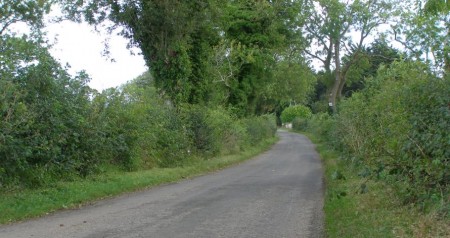
What is Hedgerow Removal?
“Hedgerow removal is part of the transition of arable land from low-intensity to high-intensity farming. The removal of hedgerows gives larger fields making the sowing and harvesting of crops easier, faster and cheaper, and giving a larger area to grow the crops, increasing yield and profits.
In the United Kingdom hedgerow removal has been occurring since World War I as technology made intensive farming possible, and the increasing population demanded more food from the land. The trend has slowed down somewhat since the 1980s when cheap food imports reduced the demand on British farmland, and as the European Union Common Agricultural Policy made environmental projects financially viable. Under reforms to national and EU agricultural policies the environmental impact of farming features more highly and in many places hedgerow conservation and replanting is taking place.
In England and Wales agricultural hedgerow removal is controlled by the Hedgerows Regulations 1997, administered by the local authority.” – 7.—(1) A person who intentionally or recklessly removes, or causes or permits another person to remove, a hedgerow in contravention of regulation 5(1) or (9) is guilty of an offence.’
[Source: http://en.wikipedia.org/wiki/Hedgerow_removal]
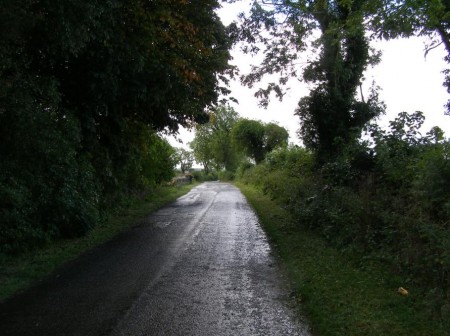
Hedgerow Removal is a serious threat to the biodiversity of wildlife across the British Isles
The hedgerow, “a ubiquitous staple of the British countryside, is actually a species under threat and between 1940 and 1990, the common hedgerow underwent a dramatic decline; predominantly due to human influence. More worryingly, the cornucopia of British wildlife that used to thrive in these hedgerows is suffering from the decrease in natural habitat. A combination of increased urbanisation, a rise in the intensity of farming and therefore field size, overgrazing by livestock and improper maintenance have all had a detrimental effect on our hedgerows.
Another key human factor is the collective ignorance of the 1997 Hedgerow Regulations that demand the application for a removal notice for any hedgerow exceeding thirty years of age. There are hedgerows in the UK that date back from before the Enclosure Acts period – 1720 – 1840 and it is a dreadful thought that this precious rural heritage is potentially being destroyed.”
[Source: Josh Ellison of Floral & Hardy]
“Between 1984 and 1993 185,000km of hedgerow in England and Wales was lost.
This decline was not simply important in a British context but also in a European context. This is because hedged landscapes are found in relatively few areas: parts of northern France; northern Italy; the Austrian Alps and the Republic are Ireland.”
[Source: Naturenet website – ‘ Hedgerow Protection in England and Wales’ by Alina Congreve. ^ http://www.naturenet.net/articles/congreve/index.html]
.
[The following article by Emily Dugan appeared in the British Sunday newspaper, The Independent, on Sunday 29th August 2010.
Source: http://www.independent.co.uk/environment/nature/are-we-losing-the-fight-to-save-our-hedgerows-2064800.html]
Are we losing the fight to save our hedgerows?
“A decade after the first legal moves to protect them, they are still under attack – and now they could fall victim to spending cuts
They are the living seams that have typified the British countryside for centuries. But now hedgerows are disappearing fast, and a report published tomorrow will say we are not doing enough to protect them.
Research from the Campaign to Protect Rural England has found that though hedgerows enjoy more protection than ever before, in England their overall length fell by 26,000 kilometres between 1998 and 2007. The study, England’s Hedgerows: Don’t Cut Them Out!, calls for current legislation to be strengthened.
As well as having a nostalgic place in the aesthetics of the countryside, hedgerows are a vital part of the ecosystem. Research by Hedgelink, a network of British hedge conservation groups, shows that without them some 130 species – from the hedgehog and the dormouse to stag beetles and the cuckoo – would be under threat.
Although “important” hedgerows are protected by law, the majority can be taken down if a landowner wishes, which has resulted in many being dug up to create larger fields that are easier to harvest. For the past 20 years, the Government has provided financial help to landowners to restore and manage hedgerows. But most have still been left unmanaged, sometimes growing into larger trees offering fewer benefits to wildlife because they are less dense at ground level.
The CPRE study focused on England, but the picture nationwide is similarly grim.
Nigel Adams, vice-chairman of the National Hedgelaying Society, said: “The hedgerow is the unsung hero of our countryside. It’s often overlooked, but visitors to England say it’s what makes it so special. The majority are not used for their original purpose [as an animal barrier], but people recognise their importance in terms of wildlife and history.”
Since 1998, the number of legally protected hedgerows has risen by 18 per cent. Currently, 42 per cent of the UK’s hedgerows are protected, but the CPRE fears that the narrow criteria required to register a stretch of hedge as “important” will mean many more are lost.
To qualify for legal protection, a hedge must be at least 20 metres long, 30 years old and meet strict criteria on heritage and numbers of animals and plants relying on it. Some hedges were easy to register, such as Judith’s Head in Cambridgeshire, which is Britain’s oldest, having stood for more than 900 years. But for non-celebrity hedges, the future is dicey. More than two-thirds of local authorities surveyed by CPRE said that the current Hedgerow Regulations needed to be simplified to make them more effective.
Emma Marrington, author of the report, said: “The length of hedgerows in the country is declining, which is worrying. They’re a part of our heritage, but they also offer huge benefits to wildlife and the environment in general. It’s over a decade since the introduction of the Hedgerows Regulations, and the time is ripe for the Government to make improvements that give local authorities the power they need to better protect the great diversity of England’s hedgerows.”
The CPRE is concerned that hedgerow protection programmes could be at risk when the Department for Environment, Food and Rural Affairs (Defra) makes spending cuts in the autumn. “The Defra spending cuts could affect the money for schemes like this,” Ms Marrington said. “I can see how hedgerows could be overlooked; they’re taken for granted as being a part of the English countryside, and people don’t realise how much they’re at risk.”
If hedgerows in Britain decline further, so too will those species that depend on them. Jim Jones of the People’s Trust for Endangered Species is running a study of the impact of disappearing hedgerows on dormice, a species whose population has declined by 40 per cent in 20 years. “Dormice have disappeared from seven counties where they existed in the 1800s, at the same time as hedgerows have declined,” he said. “Hedgerow corridors are crucial because they allow them to forage and move around.”
Species in peril: An ecosystem teeming with life
Mammals
Dormice, harvest mice, hedgehogs, six species of bat, and polecats are all at risk as hedgerows decline. They rely on the covered corridors that allow them to move around.
Plants
The copse bindweed and the Plymouth pear are among the plants that flourish in hedgerows.
Fungi and lichens
From the sandy stilt puffball to the weather earthstar fungus, many fungi do particularly well in hedgerows. Lichens such as the orange-fruited elm lichen and the beard lichen are also at risk.
Invertebrates
Stag beetles, brown-banded carder bees and large garden bumblebees are among those at risk. More than 20 of Britain’s lowland butterfly species breed in hedgerows, including the brown hairstreak and the white-letter hairstreak butterfly.
Reptiles and amphibians
Hedgerows connecting with ponds are vital for great crested newts to move through the countryside. The common toad, grass snake, slow worm and common lizard are also at risk.
Birds
Many woodland birds rely on taller hedges for breeding. The turtle dove, grey partridge, cuckoo, lesser spotted woodpecker, song thrush, red-backed shrike and yellowhammer are all in danger.”
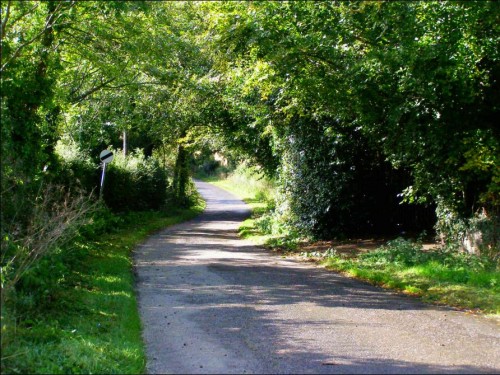
Further Reading:
.
[1] Naturenet website ‘Hedgerow Protection in England and Wales’ by Alina Congreve. ^ http://www.naturenet.net/articles/congreve/index.html]
[2] Hedgelink website homepage – ‘the first place to look for information on the UK’s native hedges, hedgerow conservation and hedge management.’ http://hedgelink.org.uk/
[3] Hedgelink website – ‘ Hedgerow Biodiversity Action Plan‘ http://www.hedgelink.org.uk/index.php?id=29
[4] Hedgelink website – ‘Hedgerow management’ http://www.hedgelink.org.uk/index.php?id=30
[5] Hedgerowmobile website – ‘Hedgerows, Hedges and Verges of Britain and Ireland, exploring the legal and environmental aspects of British and Irish hedgerow and verge ecology, ecotones as well as management strategies.’ http://hedgerowmobile.com/
[6] UK Legislation.gov.uk – ‘ the official home of enacted revised UK legislation.‘ http://www.legislation.gov.uk/uksi/1997/1160/contents/made
[7] University of Reading (England) – ‘ Environmental Challenges in Farm Management [ECIFM] – changes in habitat’ http://www.ecifm.reading.ac.uk/habitat.htm
[8] Epping Forest District Council (England) – ‘ Prosecution for the Unauthorised Removal of Hedgerows’ (8th September 2010), http://www.eppingforestdc.gov.uk/news/2010/prosecution_unauthorised_removal_hedgerows.asp
[9] Norfolk Biodiversity Partnership (England) – ‘Habitat Action Plans – Hedgerows’ http://www.norfolkbiodiversity.org/actionplans/habitat/hedgerows.asp
[10] South Straffordshire Council (England) – ‘Hedgerows (Field and Countryside)’ http://www.sstaffs.gov.uk/your_services/architectural__landscape_serv/hedgerows_field_and_countrysi.aspx
[11] The Sunday Times (UK) – article by Richard Girling July 12, 2009: ‘ Britain’s wildlife: Work on the wild side’ – to save our wildlife we must get our priorities right. How far should we meddle with the animal kingdom?’ http://www.timesonline.co.uk/tol/news/environment/article6685127.ece
[12] The Telegraph (UK) – article by Charlie Brooks 16 th July 2009: ‘ Bird-brains who undermine our farmers‘ – when it comes to conservation, landowners can be trusted to make the right decisions. ‘The European Union Habitats Directive has claimed that some 90 per cent of the UK’s threatened habitats are “in poor shape and therefore not supporting the range of wildlife they should do.” http://www.telegraph.co.uk/comment/personal-view/5843663/Bird-brains-who-undermine-our-farmers.html
[13] Countryside Jobs Service (North Yorkshire, England) – Countryside Jobs Service in association with The Tree Council For National Tree Week launched its Hedge Tree Campaign on 23 November 2009. http://www.countryside-jobs.com/Focus/Previous/Nov09.htm
[14] Wikipedia http://en.wikipedia.org/wiki/Hedgerow_removal
.
– end of article –
Tags: biodiversity, British fauna, Campaign to Protect Rural England, CPRE, DEFRA, dormice, England's hedgerows, European Union Common Agricultural Policy, hedge tree planting, hedgerow, hedgerow maintenance, hedgerow removal, hedgerow trees, Hedgerows Regulations 1997, Ireland's hedgerows, rural heritage, Scotland's hedgerows, urbanisation, Wales' hedgerows, wildlife corridors
Posted in Threats from Development, Threats from Farming | No Comments »
Add this post to Del.icio.us - Digg
|
|
 This is a Tiger Quoll (Dasyurus maculatus)
This is a Tiger Quoll (Dasyurus maculatus)


















































